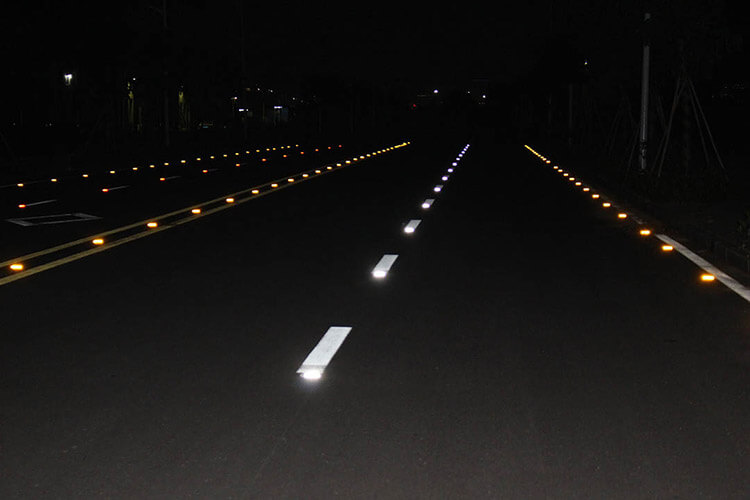Solar road stud or solar road marker, is a kind of road stud, set up along the road surface, used at night or under rainy and foggy weather, indicating the direction of the road, composed of retro-reflective material, shell, solar panels, LEDs, synchronized control devices, with active light-emitting and passive reflective performance of visual guidance facilities, usually used in combination with marking to display the road conditions.
The focus of highway construction is gradually shifting to mountainous areas and mountainous regions where economic development is relatively lagging behind. Mountainous highways, wind speeds are more significantly affected by mountain ranges and river valleys, with an average wind speed of only 1.2 m/s. Wet and rainy climatic conditions coupled with lush vegetation and forested environments, so that the road section is often foggy. And because highways usually span long distances, especially many highways pass through rural and mountainous areas, making the highway relatively complex. The distribution of fog is often very uneven, with visibility being fairly clear on one section and foggy on another. Since this situation usually occurs at night, high-speed vehicles suddenly driving into the fog zone, the driver will feel the vision suddenly darkened, some drivers can not adapt to the sudden change in vision, will produce a sense of panic, which is easy to cause traffic accidents.
Features
1、Luminous brightness
Ordinary reflective road studs reflective brightness of only 300-400 MCD, while the luminous brightness of the solar road studs up to 2000 MCD or more, is the former 6-7 times, high-intensity light can be in the night through the rain and fog, safe and effective for drivers to guide the direction.
2、Active luminescence, dynamic warning
Solar road studs flash at the same time at night (when the light is dark) at a certain frequency, and human vision is more sensitive to changes, so their dynamic warning effect is very strong. Active luminescence can not only avoid the interference of rain and fog to the greatest extent possible, but also can be separated from the dependence on car lights, the visual distance is farther, the effect is better. Solar road studs in rainy and foggy weather as well as in the whole road or uphill and downhill, bends, accident-prone areas, bridges outlining the road contour, inducing the driver's line of sight and thus eliminating safety hazards has played a fairly important role. At the same time flashing lights not only does not make the road driver discomfort, blinding feeling, but the formation of a beautiful band of light, leading the road driver to drive safely. Not at the same time flashing the road spike is easy to cause visual confusion, long time watching easy to distracted feeling. There is a sense of terror in the dark night.
Working Principle
During the daytime, the solar panel absorbs sunlight, converts solar energy into electrical energy, which is stored in the energy storage device (battery or capacitor). At night, the electrical energy in the energy storage device is automatically converted into light energy (controlled by photoelectric switch), which is emitted through the LEDs to outline the road and induce the driver's line of sight.
Solar spikes can be categorized into buried and protruding types according to the different installation locations.
The former is generally used in the center line, the latter is generally used for the edge line. This is because the installation of the center line of the solar energy road spike on the pressure resistance performance requirements are particularly high, in order to solve this problem, had to bury the solar energy road spike into the ground, exposed to the ground only about 5 millimeters. And used in the edge of the line of solar studs on the pressure resistance performance requirements are not particularly high, protruding from the ground can still work effectively.
Solar spike according to the different energy storage components can be divided into capacitive and battery-type, the former's service life of up to five to seven years, the latter's service life is generally in one year to three years ranging.
Because buried solar road studs are very destructive to the road surface, and the cost of capacitive solar road studs is too high, so the current application of the most raised battery solar road studs.
Regarding performance metrics, the performance of a solar spike is measured in the following ways:
1. Pressure-resistant performance
If the solar studs can not withstand a certain pressure, in the car crushed or impact will be easily broken, naturally can not work properly, so pressure is a basic condition of the normal work of the solar studs. But the problem is that the solar spike itself is an electronic product, including electronic parts, want to make the electronic part also has a high degree of pressure resistance is not an easy thing, so generally speaking, the pressure resistance of the solar spike to be worse than ordinary spike. The current technical requirements of the Ministry of Transportation is 10 tons.
There are several ways to effectively improve the compressive properties of solar road studs:
(1) The exposed solar panel is made of PC bulletproof material to enhance the pressure resistance of the electronic part;
(2) Use IC control as much as possible to reduce the volume of the electronic circuit to reduce the pressure on the electronic part;
(3) Enhance the thickness of the case to share the pressure on the electronic part.
2. Sealing performance
If the solar spike is not completely sealed, it will naturally seepage, seepage will cause a short circuit, the consequences are also disastrous, so a qualified solar spike sealing performance is also must pass.
There are several ways to improve the sealing performance of solar road studs:
(1) Separation design: LED lampshade and internal circuit board adopt isolation design, even if the LED lampshade is broken, the inside of the solar spike is still guaranteed not to seepage water.
(2) Strong neutral bonding material is used to ensure that the solar panel, LED lampshade and dowel shell are tightly bonded without any gap in between.
3. Brightness
Solar road studs active light-emitting, clear outline of the road; compared to reflective road studs, a very important feature is the luminous intensity. This indicator is required by the Ministry of Transportation 2000 MCD.
4. Stability
Battery life is an important factor in determining the life of solar road studs is the life of the battery, the choice of battery is critical. Currently there are two types of batteries on the market can be referred to, one is after 500 times of charging and discharging, the battery capacity is reduced to 50%; the other is after 1000 times of charging and discharging, the battery capacity is reduced to 79%.
Battery life should not only be long enough, but also to be able to work properly in a large temperature range. Battery internal chemical substances, if the temperature is too high or too low, the battery can not work, solar road spike battery operating temperature range must meet the requirements of the actual use of the environment. The requirements of the State Department of Transportation is -10 degrees to 50 degrees, the actual environment is often beyond this range, which puts forward higher requirements for the battery.
The design of electronic circuit boards must follow the principle of simple and effective design. Dowels need to work in high and low temperature environments. Electronic components should be strictly selected with good temperature characteristics, because any problem with any electronic component may paralyze the whole system. The power consumption design of the circuit board is especially selected from ultra-low power consumption components.
Welding welding must be reliable, because the solar spike every day to withstand the vehicle's crushing and impact, a little bit of loose soldering joints will lead to loose lines and fall off. So in the choice of welding gun and solder when you must select high-quality products to ensure that the solder joints are firm and reliable, can be a long time in a relatively "harsh" environment.
Solar panels solar panels directly absorb solar energy, and convert light energy into electricity, can be said to be the first link in the whole working system of solar road nail; it directly determines the level of efficiency of the solar road nail working efficiency. Now commonly used is monocrystalline silicon solar panels, this is because the monocrystalline silicon solar panels have a high photoelectric conversion rate, about 14%, can maximize the solar energy into electricity to ensure that the solar road nail work when the energy supply. In addition, the solar panel must be high hardness, wear-resistant circuit board.
Solar panels are subjected to the wear and tear of wheels every day, and if they are not strong enough, they can easily wear out, which in turn affects the conversion efficiency of solar panels.
5. Battery matching performance
In the standard test conditions placed 8 hours, the rated capacity of the battery should meet the spike normal light 72 hours; even if the sun's illuminance is less than 1000LX, the battery is charged for 8 hours, its rated capacity should meet the spike normal light 12 hours of need. This point must also pay special attention. If the battery matching performance is not good, in rainy weather there will be insufficient battery storage power and lead to the solar spike can not light. In this way, the solar spike has no practical value, it can not be used at all. Herein lies the limitation of capacitive solar pins. In the standard test conditions placed 8 hours, the rated capacity of the capacitor can only meet the normal light of the road spike 12-14 hours of need, so that the capacitive solar road spike on the actual use of the environment is very demanding, not only the sun should be strong enough, and there can not be a continuous cloudy and rainy weather, otherwise it will be difficult to work properly.
6. Environmental adaptability
The use of solar road spike environment is complex and variable, temperature, humidity may be very different. Northern winter temperatures are very low, the southern summer temperature is very high, the Northwest region, the temperature difference between day and night and particularly large, the southeast humid, the northwest dry, these will affect the solar spike work properly, so the design of the solar spike should be fully taken into account the environmental adaptability.
The current requirements of the Ministry of Transportation on the temperature is -20 ℃ to 85 ℃ range, but also between 20 ℃ and 60 ℃ to do three cycle test to see whether it can adapt to the environmental requirements. The requirements of the Ministry of Transportation on the solar road spike wet and hot performance is at 45 ℃, relative humidity of 98% of the conditions of the test after 48 hours can still work normally.
The environmental adaptability of the solar spike is a comprehensive test of its mechanical and electrical properties, involving structural design, circuit design, electronic device performance and other aspects, even including its production process. This also requires that all aspects of the work should be done in order to ensure that the solar spike has a better environmental adaptability.

